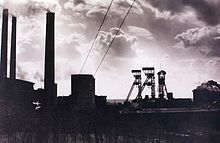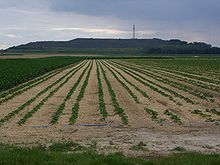Sophia-Jacoba colliery
| Sophia-Jacoba colliery | |||
|---|---|---|---|
| General information about the mine | |||
| Headframe of shaft 3 (industrial monument) | |||
| Funding / year | Max. = 420,000 t | ||
| Information about the mining company | |||
| Operating company | Ruhrkohle AG | ||
| Employees | up to 5669 | ||
| Start of operation | 1914 | ||
| End of operation | 1997 | ||
| Funded raw materials | |||
| Degradation of | Hard coal | ||
| Geographical location | |||
| Coordinates | 51 ° 3 '27.9 " N , 6 ° 12' 52.5" E | ||
|
|||
| Location | Ratheim | ||
| local community | Hückelhoven | ||
| country | State of North Rhine-Westphalia | ||
| Country | Germany | ||
| District | Aachen district | ||
The Zeche Sophia-Jacoba in Hückelhoven - Ratheim part of the Aachen coal area and promoted from 1914 to its closure on 27 March 1997 anthracite - coal . From 1960 until the company was closed, it was considered the most modern coal mine in Europe.
history
Emergence
The Rurtal is a geological rift valley (see geology of the Lower Rhine Bay ). The rock strata along its eastern and western fault lines are e.g. T. shifted vertically against each other by several hundred meters. The Aachen Mining Authority therefore took the view in the 19th century that it was not possible to find the coal-bearing strata that were mined in the Aachen mining area east of the Rur.
Dürener mine entrepreneur Friedrich Honigmann disagreed and began in 1885 with drilling in the area Hückelhoven, Millich and Schaufenberg , where he remained until 1899 29 Fields license product left. In economic terms, however, coal mining could only be considered when a railway line was planned between Baal and Roermond in 1908, which also touched Hückelhoven (see Jülich – Dalheim railway line ). With the opening of this railway line in 1911, the sinking of shafts 1 and 2 in Hückelhoven, which were completed in 1914 and 1919, respectively, began. From 1914 - initially with only 8 miners - the first anthracite coal was mined.
Between 1916 and 1920 NEMOS ( Nederlandsche Maatschappij tot Ontginning van de Steenkolenvelden ) took over all shares of Honigmann's heirs. The colliery was founded in 1917 after the wives of NEMOS founder Dr. Fentener van Vlissingen and the mining board chairman Pieter de Vooys.
construction
In 1926 the workforce had grown to 2,161, and in 1933 even to 3,395. The Schaufenberg housing estate was founded to meet the increased demand for living space. Between 1919 and 1925, workers' settlements were built in Hückelhoven and Schaufenberg under the direction of the Dutch architect Emil Emanuel Strasser to create living space for the miners and their families. In 1929 a mountain vocational school was opened.
1927 began with the sinking of the shaft 3, on which a highly visible and 1934 headframe was built. Also in 1934, shaft 4 near Ratheim was put into operation with a headframe ; it initially only served as a weather and material shaft. In 1936 the workforce at the colliery numbered around 4,500. Large quantities of coal were also exported. The low wages of the 1930s fueled discontent with the National Socialist economic policy in the workforce. In 1937, in addition to ponies, the first diesel locomotives were used underground . The use of the pit horses did not end until 1951.
In the autumn of 1944, as the front approached, the colliery came under heavy artillery fire, which destroyed large parts of the facilities and three quarters of the works' own apartments. The workforce was evacuated; an emergency crew initially ensured the continued existence of the mine, but also had to leave the region in January 1945. Over a million cubic meters of water collected below the 360 m level, which had to be pumped out after the war . In February 1945 US troops captured the area . Production was resumed at the end of October 1946.
centralization

After extensive development of new mining fields , the mine management decided in the mid-1950s to build a central shaft system. Ratheim was selected as the location for this because of its central location, because the majority of the coal fields were within a 7.5 km radius of shaft 4. Shaft 4 was expanded into a production shaft; a winding tower made of reinforced concrete was put into operation in 1959 (architect Fritz Schupp ). This year the workforce reached its highest level of 5669 employees (in 1986 there were still about 5000 miners working on the mine).
In 1960 shaft 5 in Wassenberg- Rosenthal was put into operation and the sinking of shaft 6 / HK near Ratheim, which, also provided with a reinforced concrete headframe, was completed in 1964. In 1979 the central shaft system at Ratheim was expanded to include a leveling system , and in 1983 to include a coal washer .
Sophia-Jacoba was to receive an underground connection with the planned Staatsmijn Beatrix in the neighboring Netherlands in the 1950s . The decline of the European coal industry prevented the implementation of these plans; the Staatsmijn Beatrix was closed in 1962 without ever producing coal.
Decline
In 1973 the Dutch company Robeco NV took over the mine.
In 1984 the colliery produced a record 420,000 tons of "Extrazit". In 1988 the Supervisory Board decided for the first time to significantly reduce funding and workforce. In spring 1989 Robeco started sales talks with Ruhrkohle AG (RAG). In September 1989 the Sophia-Jacoba union was converted into a GmbH; it was transferred to RAG with the trading company SJH with effect from January 1, 1990.
Because of its high production costs, hard coal mining in Germany has only been possible since the 1960s with coal subsidies in the billions; Imported coal was and is much cheaper. Many politicians criticized these subsidies and called for these tax dollars to be used for other purposes, e.g. B. the FDP politician Jürgen Möllemann . In 1990 and 1991 the miners struck and protested against the closure plans. On November 11, 1991, it was decided to close the colliery for good in 1997. On March 27, 1997 the last coal was mined and on June 30, 1997 the mine was shut down.
The former administration building, which is under monument protection, had to be demolished in the winter of 2006/2007 due to mountain damage . The district heating power plant on the old colliery site in Hückelhoven is the only part of the colliery still in operation and has been owned by the Eschweiler Mining Association ( EBV) since 1997 .
With the closure of the last German hard coal briquette factory on March 31, 2008 (almost exactly 11 years after cessation of underground operations), the era of hard coal mining ended in the Ratheim and Hückelhoven area. The reason for the closure was declining demand in the house fire market. The briquette factory building was blown up in February 2009.
Spoil heaps
The mine created four spoil heaps in the Hückelhoven area :
- The oldest dump nestles against the canteen mountain between Schaufenberg and Hückelhoven; it is still recognizable today by the old robinia population.
- The second oldest heap was built between Schaufenberg and Millich. It was demolished in the 1950s by a private company in order to be able to use the remaining coal economically. Only remnants along Schaufenberger Strasse are reminiscent of this heap.
- The 70 meter high Millicher heap is located on the L117 between Millich and Hückelhoven and is now accessible with hiking trails and viewpoints. → Main article: Millicher Halde .
- The Ratheimer Halde is visible from afar on the edge of the Rurgraben between Ratheim and Altmyhl . It was stocked with overburden until the colliery closed in 1997; its highest point is 140 m above sea level. NN . The planting of the lower areas dates from the mid-1970s, those of the upper areas from the 1990s.
museum
Since the colliery closed, former miners have tried to keep the memories of the region's mining history alive. They have come together to form a development association for Shaft 3 , which maintains a mining museum on the site of the former colliery. In addition to group tours and the presentation of films, z. B. exhibitions, flea markets and, since 2018, the international open air festival SommerMusik Schacht3 in front of the winding tower.
Exactly ten years after the last coal production, on March 27, 2007, a visitor mine was officially opened in the presence of the former Federal Labor Minister Blüm . It was built by the association members themselves. The outdoor area has been used as a temporary drive-in cinema since 2008 .
literature
- Michael Farrenkopf, Stefan Przigoda: Black Silver - The history of the hard coal mine Sophia-Jacoba . Essen 1997.
- Friedrich Schunder: History of the Aachen hard coal mining Verlag Glückauf, Essen 1968.
- J. Bürger: The coal mine Sophia-Jacoba and its importance for the region . - in: District of Heinsberg (ed.): Heimatkalender des Kreis Heinsberg 1997, p. 177ff
- E. Offermanns: Chronicle of the Sophia Jacoba union. Hard coal mine in Hückelhoven . - Own print 1964
- StadtWandel history workshop Hückelhoven (ed.): We couldn't make any big leaps. - Everyday stories from the miners' settlements in Doveren, Hilfarth, Hückelhoven, Ratheim and Schaufenberg. Volume 1 + 2, Hückelhoven 2003/2005
Web links
Footnotes
- ↑ In 1914, the Hückelhoven 2 mine began producing coal.
- ↑ Germany report by Sopade. 3rd year 1936. Salzhausen and Frankfurt / M. 1980. p. 1198
- ↑ a b www.archive.nrw.de
- ^ Aachener Zeitung: Hückelhoven / Region: 20 years ago: Sophia-Jacoba dies. Retrieved October 19, 2019 .
- ↑ As of mid-2016








